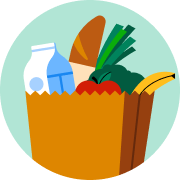
Fast delivery
Get in as fast as 1 hour

It’s all local
Shop your favorites

Direct chat
Connect with shoppers


About
Ingredients
Dried Whey Protein Concentrate, Animal Fat (Preserved with BHA, BHT, Citric Acid & Ethoxyquin), Dried Whey, Dicalcium Phosphate, Calcium Carbonate, L-Arginine, Taurine, Choline Chloride, Sodium Silico Aluminate, Potassium Sorbate (Preservative), Dried Skimmed Milk, Artificial Flavor, DL-Methionine, Ferrous Sulfate, Maltodextrin, Zinc Sulfate, Magnesium Sulfate, Vitamin E Supplement, Niacin Supplement, Vitamin A Supplement, Manganese Sulfate, Ascorbic Acid, Sodium Selenite, Biotin, Vitamin D3 Supplement, Calcium Pantothenate, Calcium Iodate, Vitamin B12 Supplement, Mineral Oil, Riboflavin Supplement, Folic Acid, Thiamine Mononitrate, Menadione Sodium Bisulfate Complex (Source of Vitamin K Activity), Cobalt Sulfate, Pyridoxine Hydrochloride, Copper Sulfate.
Directions
Important Consumer Information: Feeding: Milk Replacer for Cats and Kittens: Special Note: It is very important that newborn kittens receive colostrum from the mother in the first 24 hours of life whenever possible. Colostrum is the first milk produced by the mother after queening (giving birth), and contains protective antibodies and other nutrients essential for healthy growth and development in the kitten. This product is intended for intermittent or supplemental feeding only. Mix 1 enclosed scoop (approximately 5 ml/cc or one teaspoon, measuring approximately 2 grams of dry powder by weight) of milk replacer powder into 2 teaspoons (10 ml/cc) of warm water (110-120 degrees F) by gently shaking or stirring until the powder is completely dissolved. Before feeding, test the temperature of the milk by squeezing a drop on your arm. It should feel comfortably warm. Feed the mixed milk replacer solution at room to body temperature (no warmer than 98.8 degrees F). Offer at a rate of 2 tablespoons (about 30 ml or 1 fluid ounce) for each 4 ounces (1/4 pound or about 113 grams) of kitten body weight daily. Divide the total amount of daily milk replacer solution evenly between regularly spaced feedings - for very young, small, or weak kittens this might be as often as every 2-3 hours; for older larger kittens every 6-8 hour may be sufficient. Weigh kittens every few days to ensure adequate feeding. Please see the table below for feeding guidelines based on kitten age and body weight. Adjust the feeding schedule and the amounts fed as needed for kitten's body condition and appetite, using your own good judgment. Healthy kittens should double their birth weight in the first two weeks of life (gaining approximately 10-15 grams per day). Consult with your veterinarian for advice on feeding orphaned or rejected kittens. Food Supplement for Older (Weaned) Kittens, Show Cats and Old Cats: Feed at a rate of 1 enclosed scoop (1 teaspoon) of milk replacer powder for each 5 pounds of body weight - mix dry powder in equal proportions into the daily food. Be sure to mix with fresh food each day to help prevent spoilage. Food Supplement for Pregnant and Lactating Queens: Feed at a rate of 2 enclosed scoops (2 teaspoons) of milk replacer powder for each 5 pounds of body weight until 2 weeks after queening - mix dry powder in equal proportions into the daily food. Be sure to mix with fresh food each day to help prevent spoilage. Storing Milk Replacer: Reconstituted liquid milk replacer may be refrigerated for up to 24 hours. Stir thoroughly, then re-warm the solution gently in the feeding bottle over a warm water bath - do not microwave. Feed at room body temperature (no warmer than 98.8 degrees F). Do not heat formula because milk may be too hot. Discard any re-warmed milk replacer solution left over after feeding. Dry milk replacer powder should be stored in a tightly closed container in a cool, dry place, out of direct sunlight. Use within 18 months of manufacture (by the best by date on the package). Dry powder may be stored in a tightly sealed container in the freezer to extend shelf life up to one year. Birth: Typical birth weight is about 4 oz (113 grams); 10-12 feedings daily (every 2.5-3 hrs) (feed smaller, younger kittens more frequently than older, larger kittens); 2.5-3 ml per feeding; 30 ml (approx. 1 fl oz) daily. 7 Days: 6.5 oz (184 g); 8-10 feedings daily (every 2.5-3 hrs) (feed smaller, younger kittens more frequently than older, larger kittens); 4.5-6 ml per feeding; 45-50 ml (approx. 1.5 fl oz) daily. 14 Days: 9 oz (255 g) body weight; 6-8 feedings daily (every 3-4 hrs) (feed smaller, younger kittens more frequently than older, larger kittens); 7.5-11.5 ml per feeding; 60-70 ml (approx. 2-2.4 fl oz) daily. 21 Days: 11.5 oz (326 g) body weight; 4-6 feedings daily (every 4-6 hrs) (feed smaller, younger kittens more frequently than older, larger kittens); 13.5-22 ml per feeding; 80-90 ml (approx. 2.7-3 fl oz) daily. 28 Days: 14 oz (397 g) body weight; 3-4 feedings daily (every 6-8 hrs) (feed smaller, younger kittens more frequently than older, larger kittens); 25-35 ml per feeding; 100-110 ml (approx. 3.4-3.7 fl oz) daily. 42 Days: 16.5 oz (468 g) body weight; 2-3 feedings daily (feed smaller, younger kittens more frequently than older, larger kittens); 40-65 ml per feeding; 120-130 ml (approx. 4-4.4 fl oz) daily. Kitten Body Weight: Weights are approximate - feed by weight, not by age. Number of Feedings Daily: Feed smaller, younger kittens more frequently than older, larger kittens. Amount of Liquid Milk Replacer per feeding in milliliters (ml or cc). Amount of Liquid Milk Replacer daily in milliliters (ml) and fluid ounces (fl oz). Ask a Vet: Stimulation is required for the release of both stool & urine until 3 weeks of age. Use a warmed, wet wash cloth or a rough paper towel. Make sure the towel is wet. Slowly massage the genitals until the kitten has urinated and defecated. The stool should be softly formed, not runny. If the stool is runny, it is a possibility you are overfeeding the kitten or it has a parasite. It is better to feed more often and give less food each time than to overfeed a kitten. Potty them before and after each feeding.
About
Ingredients
Dried Whey Protein Concentrate, Animal Fat (Preserved with BHA, BHT, Citric Acid & Ethoxyquin), Dried Whey, Dicalcium Phosphate, Calcium Carbonate, L-Arginine, Taurine, Choline Chloride, Sodium Silico Aluminate, Potassium Sorbate (Preservative), Dried Skimmed Milk, Artificial Flavor, DL-Methionine, Ferrous Sulfate, Maltodextrin, Zinc Sulfate, Magnesium Sulfate, Vitamin E Supplement, Niacin Supplement, Vitamin A Supplement, Manganese Sulfate, Ascorbic Acid, Sodium Selenite, Biotin, Vitamin D3 Supplement, Calcium Pantothenate, Calcium Iodate, Vitamin B12 Supplement, Mineral Oil, Riboflavin Supplement, Folic Acid, Thiamine Mononitrate, Menadione Sodium Bisulfate Complex (Source of Vitamin K Activity), Cobalt Sulfate, Pyridoxine Hydrochloride, Copper Sulfate.
Directions
Important Consumer Information: Feeding: Milk Replacer for Cats and Kittens: Special Note: It is very important that newborn kittens receive colostrum from the mother in the first 24 hours of life whenever possible. Colostrum is the first milk produced by the mother after queening (giving birth), and contains protective antibodies and other nutrients essential for healthy growth and development in the kitten. This product is intended for intermittent or supplemental feeding only. Mix 1 enclosed scoop (approximately 5 ml/cc or one teaspoon, measuring approximately 2 grams of dry powder by weight) of milk replacer powder into 2 teaspoons (10 ml/cc) of warm water (110-120 degrees F) by gently shaking or stirring until the powder is completely dissolved. Before feeding, test the temperature of the milk by squeezing a drop on your arm. It should feel comfortably warm. Feed the mixed milk replacer solution at room to body temperature (no warmer than 98.8 degrees F). Offer at a rate of 2 tablespoons (about 30 ml or 1 fluid ounce) for each 4 ounces (1/4 pound or about 113 grams) of kitten body weight daily. Divide the total amount of daily milk replacer solution evenly between regularly spaced feedings - for very young, small, or weak kittens this might be as often as every 2-3 hours; for older larger kittens every 6-8 hour may be sufficient. Weigh kittens every few days to ensure adequate feeding. Please see the table below for feeding guidelines based on kitten age and body weight. Adjust the feeding schedule and the amounts fed as needed for kitten's body condition and appetite, using your own good judgment. Healthy kittens should double their birth weight in the first two weeks of life (gaining approximately 10-15 grams per day). Consult with your veterinarian for advice on feeding orphaned or rejected kittens. Food Supplement for Older (Weaned) Kittens, Show Cats and Old Cats: Feed at a rate of 1 enclosed scoop (1 teaspoon) of milk replacer powder for each 5 pounds of body weight - mix dry powder in equal proportions into the daily food. Be sure to mix with fresh food each day to help prevent spoilage. Food Supplement for Pregnant and Lactating Queens: Feed at a rate of 2 enclosed scoops (2 teaspoons) of milk replacer powder for each 5 pounds of body weight until 2 weeks after queening - mix dry powder in equal proportions into the daily food. Be sure to mix with fresh food each day to help prevent spoilage. Storing Milk Replacer: Reconstituted liquid milk replacer may be refrigerated for up to 24 hours. Stir thoroughly, then re-warm the solution gently in the feeding bottle over a warm water bath - do not microwave. Feed at room body temperature (no warmer than 98.8 degrees F). Do not heat formula because milk may be too hot. Discard any re-warmed milk replacer solution left over after feeding. Dry milk replacer powder should be stored in a tightly closed container in a cool, dry place, out of direct sunlight. Use within 18 months of manufacture (by the best by date on the package). Dry powder may be stored in a tightly sealed container in the freezer to extend shelf life up to one year. Birth: Typical birth weight is about 4 oz (113 grams); 10-12 feedings daily (every 2.5-3 hrs) (feed smaller, younger kittens more frequently than older, larger kittens); 2.5-3 ml per feeding; 30 ml (approx. 1 fl oz) daily. 7 Days: 6.5 oz (184 g); 8-10 feedings daily (every 2.5-3 hrs) (feed smaller, younger kittens more frequently than older, larger kittens); 4.5-6 ml per feeding; 45-50 ml (approx. 1.5 fl oz) daily. 14 Days: 9 oz (255 g) body weight; 6-8 feedings daily (every 3-4 hrs) (feed smaller, younger kittens more frequently than older, larger kittens); 7.5-11.5 ml per feeding; 60-70 ml (approx. 2-2.4 fl oz) daily. 21 Days: 11.5 oz (326 g) body weight; 4-6 feedings daily (every 4-6 hrs) (feed smaller, younger kittens more frequently than older, larger kittens); 13.5-22 ml per feeding; 80-90 ml (approx. 2.7-3 fl oz) daily. 28 Days: 14 oz (397 g) body weight; 3-4 feedings daily (every 6-8 hrs) (feed smaller, younger kittens more frequently than older, larger kittens); 25-35 ml per feeding; 100-110 ml (approx. 3.4-3.7 fl oz) daily. 42 Days: 16.5 oz (468 g) body weight; 2-3 feedings daily (feed smaller, younger kittens more frequently than older, larger kittens); 40-65 ml per feeding; 120-130 ml (approx. 4-4.4 fl oz) daily. Kitten Body Weight: Weights are approximate - feed by weight, not by age. Number of Feedings Daily: Feed smaller, younger kittens more frequently than older, larger kittens. Amount of Liquid Milk Replacer per feeding in milliliters (ml or cc). Amount of Liquid Milk Replacer daily in milliliters (ml) and fluid ounces (fl oz). Ask a Vet: Stimulation is required for the release of both stool & urine until 3 weeks of age. Use a warmed, wet wash cloth or a rough paper towel. Make sure the towel is wet. Slowly massage the genitals until the kitten has urinated and defecated. The stool should be softly formed, not runny. If the stool is runny, it is a possibility you are overfeeding the kitten or it has a parasite. It is better to feed more often and give less food each time than to overfeed a kitten. Potty them before and after each feeding.
Common questions
Learn more about how to place an order here.
Then, when you arrive at the store of your choice, use the Instacart app to notify us. Depending on the store, a shopper or store employee will bring the groceries to your car, or you can pick them up at the designated area.
Learn more about pickup orders here.
- Delivery fees start at $3.99 for same-day orders over $35. Fees vary for one-hour deliveries, club store deliveries, and deliveries under $35.
- Service fees vary and are subject to change based on factors like location and the number and types of items in your cart. Orders containing alcohol have a separate service fee.
- Tipping is optional but encouraged for delivery orders. It's a great way to show your shopper appreciation and recognition for excellent service. 100% of your tip goes directly to the shopper who delivers your order.
With an optional Instacart+ membership, you can get $0 delivery fee on every order over $35 and lower service fees too.
Instacart pickup cost:
- There may be a "pickup fee" (equivalent to a delivery fee for pickup orders) on your pick up order that is typically $1.99 for non-Instacart+ members. Instacart+ membership waives this like it would a delivery fee.
- Pick up orders have no service fees, regardless of non-Instacart+ or Instacart+ membership.
Learn more about Instacart pricing here.
You can set item and delivery instructions in advance, as well as chat directly with your shopper while they shop and deliver your items. You can tell the shopper to:
- Find Best Match: By default, your shopper will use their best judgement to pick a replacement for your item.
- Pick Specific Replacement: You can pick a specific alternative for the shopper to purchase if your first choice is out-of-stock.
- Don't Replace: For items you'd rather not replace, choose "Don't replace" to get a refund if the item is out of stock.
Learn more about instructions for specific items or replacements here.
- Missing items
- Incorrect items
- Damaged items
- Poor replacements
- Early/late orders
If an order never came, or you get someone else's order, you can reach out to Instacart Customer Experience.














































